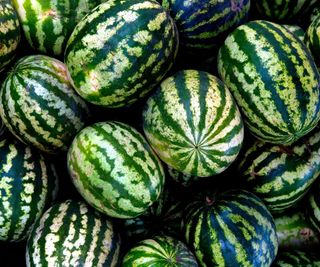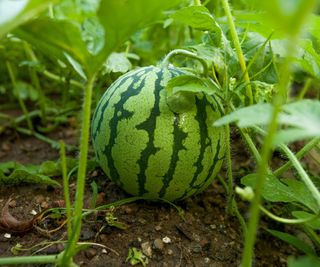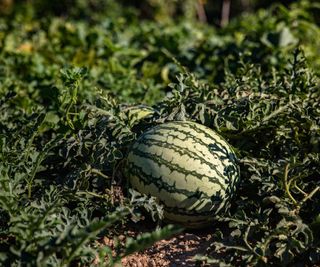How to pick a watermelon – and how to know when they're ready
Learn how to pick a watermelon for a mouth-wateringly juicy snack


Nothing is better than enjoying a fresh slice of watermelon on a hot day, especially when it comes with the satisfaction of having grown it yourself. Better yet, when ripe, watermelons are a great source of natural antioxidants which are linked to several health benefits.
Have you tried your hand at growing watermelon but have no idea when to pick them? This handy guide explains when and how to pick watermelons for a perfect summer treat.
How to pick a watermelon
Learning how to grow watermelon is a fun beginner's gardening task, however, knowing when to pick watermelon is the key to a delicious harvest and it all depends on how and when you plant watermelon.
If you grew your melon from a seed, you should expect to have a ripe watermelon around 80 days later so you can start checking for a ripe fruit around 75 days after planting. It is important to be patient – 'you'll know when melons are ripening because their sweet scent will fill the air,’ says garden editor for Homes & Gardens, Rachel Crow.
To harvest the watermelon, you should leave about two inches of stem on the fruit. Carefully use a sharp knife or heavy gardening shears to cut the melon from the vine. Once harvested, it can be stored for around a week at room temperature or two weeks in a refrigerator.
Here, we offer five things to look out for when looking to pick a watermelon.
1. Look for a uniform appearance

Whilst watermelons come in many different shapes and sizes, it is good to pick a watermelon that has a symmetrical shape with little to no irregular bumps, dents, or cuts. ‘Look for a watermelon that is dull in appearance and heavy, as this will indicate it is ripe – if it's shiny then it is still ripening.’ suggests Rachel.
Irregularities and shininess can be indicators that the watermelon did not receive enough water when it was growing, or that it was not pollinated properly. What’s more, cuts and large dents can point to the presence of insects or fungus.
On the other hand, dry weathering spots and vein-like webbing on the surface of your watermelon can indicate that the melon will be extra sweet. These spots signify excess sugar has been seeping out of the fruit as it has grown.
2. Check the grow spot

Rachel’s next tip is to ‘inspect the spot where they were sitting on the ground, as this should be creamy or slightly yellow in color. If it's white or green it is too early to harvest.'
This grow spot, also called the field spot, can tell you a lot about the status of your watermelon. Picking a yellow-spotted watermelon will grant you a sweet melon, whilst a white or green spotted watermelon will be almost flavorless.
3. Assess the weight of the watermelon

Even small watermelons can be incredibly heavy. When assessing the weight of a watermelon, you want it to feel heavy for its relative size - this means that the melon is full of water and is therefore juicer.
4. Try the tapping technique

This method can be subjective but is a favorite of watermelon farmers. When tapping or slapping a watermelon, it should produce a deep sound like a tenor. If the melon sounds hollow it is likely overripe, or, in contrast, if it makes a higher-pitched sound it is likely slightly underripe.
5. Test its firmness

As well as making sure your watermelon is ripe enough to be picked, you should also try and prevent your watermelons from becoming overripe.
Checking the rind of the watermelon is a great way to do this. Using both hands, hold the melon and squeeze gently. A ripe watermelon should not give way easily when placed under pressure. If it does, it is a good sign that your melon is overripe.
Another good test is to scratch the watermelon with your nail - you should not be able to cut or break the skin.
How do you pick a good watermelon at the store?
If growing your own watermelon isn’t something that appeals to you, or you just want to enjoy a watermelon's refreshing sweetness without waiting, picking a melon at the store is the next best option.
Checking a watermelon at the store uses many of the same techniques as checking a home-grown melon.
When picking a watermelon at the store, make sure to also inspect the stem. The stem, or what is left of it, should be dry and yellow-brown in color. A green stem may indicate that the watermelon was picked before it was ripe enough and it may lack flavor and sweetness.
For an extra sweet watermelon, also try to buy the fruit in season. The watermelon harvest season typically lasts between May and September.
Sign up to the Homes & Gardens newsletter
Decor Ideas. Project Inspiration. Expert Advice. Delivered to your inbox.

Chiana has been at Homes & Gardens for two years, having started her journey in interior journalism as part of the graduate program. She spends most of her time producing content for the Solved section of the website, helping readers get the most out of their homes through clever decluttering, cleaning, and tidying tips – many of which she tests and reviews herself in her home in Lancaster to ensure they will consistently deliver for her readers and dabbles in the latest design trends. She also has a first-class degree in Literature from Lancaster University.
-
 How to incorporate storage into open-plan spaces – 5 tricks for seamless storage
How to incorporate storage into open-plan spaces – 5 tricks for seamless storageProfessional designers and home organizers share their top five tricks for incorporating storage into open-plan spaces to keep these lofty rooms tidy
By Chiana Dickson Published
-
 Bamix immersion blender review – timelessly elegant and a treat to use
Bamix immersion blender review – timelessly elegant and a treat to useOur experts put the Bamix immersion blender to the test, using it to whizz up soups, smoothies, nut butters, and more. Here's what we thought
By Laura Honey Published